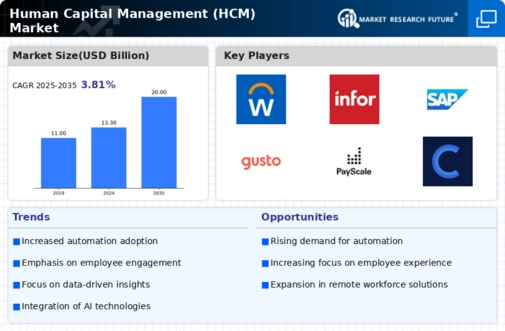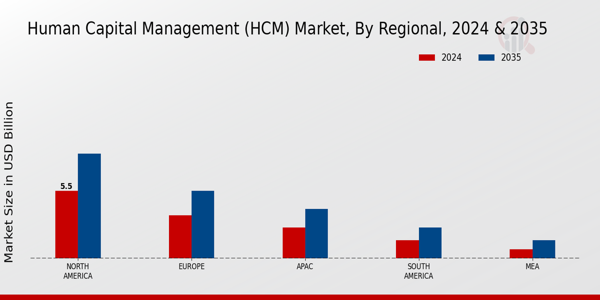Human Capital Management Size
Human Capital Management Market Growth Projections and Opportunities
The HCM market's market dynamics are made up of many elements that reflect the changing landscape of operations management and organizational effectiveness. The first factor is technological advancement in the HCM market. Traditional HR has been revolutionized by incorporating artificial intelligence, machine learning, and data analytics. However, the current use of technology changes how things are done in HCM, as shown using chatbots for team member engagement, predictive analytics for talent acquisition, and automation for routine tasks, among others. As organizations continue to realize the significance of using technological innovation to enhance workforce productivity, there is increasing demand for innovative HCM solutions. Another aspect that constitutes a part of market dynamics is the ever-changing regulatory environment. Employment laws, data protection regulations, and compliance requirements all evolve on an ongoing basis. Thus, players in this field must always keep their solutions in line with these changes so that they do not violate legal frameworks set in place to regulate them. Being able to adapt and provide solutions that are ready for compliance becomes a competitive advantage within the HCM marketplace. A complex regulatory landscape requires companies to demonstrate how their workforce management processes remain legally sound when selecting an ideal provider of human capital management services. Besides, globalization contributes to shaping the dynamics of the HCM market today, where businesses have gone international and hence need unified HCM solutions that address diverse workforce requirements needed by such firms. Multinational firms need seamless integration with local regulations, languages, and cultural nuances from their choice's vendors who offer scalable as well as globally compatible products that can serve organizations having an international footprint better. Additionally, changing demographics characterize a dynamic Human Capital Management (HCM) industry. Remote work, the gig economy, and diversified preferences within workforces indicate that flexible, adaptive HCM systems are needed (Storey 35). Consequently, traditional eight-to-five structures are being replaced by more roundabout decentralized approaches (Lange & Majorov 13). Vendors offering customized products or services meant for a diverse and scattered workforce have an edge over their peers in this dynamic market. The competitive dynamics of the HCM market are also affected by competitors' efforts to differentiate themselves through unique features as well as value propositions (Holland 112). Continuous improvement is essential for survival in overcrowded marketplaces (Purcell 114). To attain better prospects of capturing a bigger market share, vendors must focus on research and development, enhancing customer experience on their portals, as well as incorporating strategic partnerships into their business milieu.















Leave a Comment